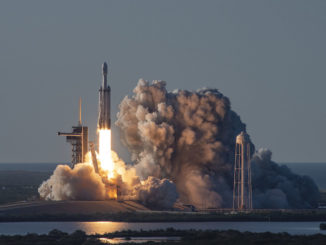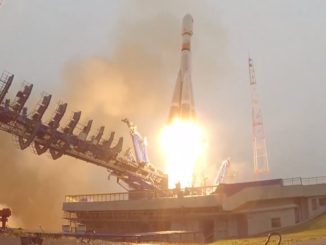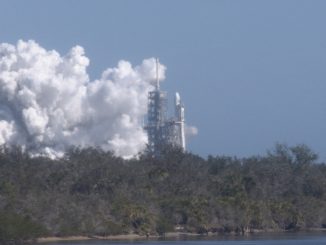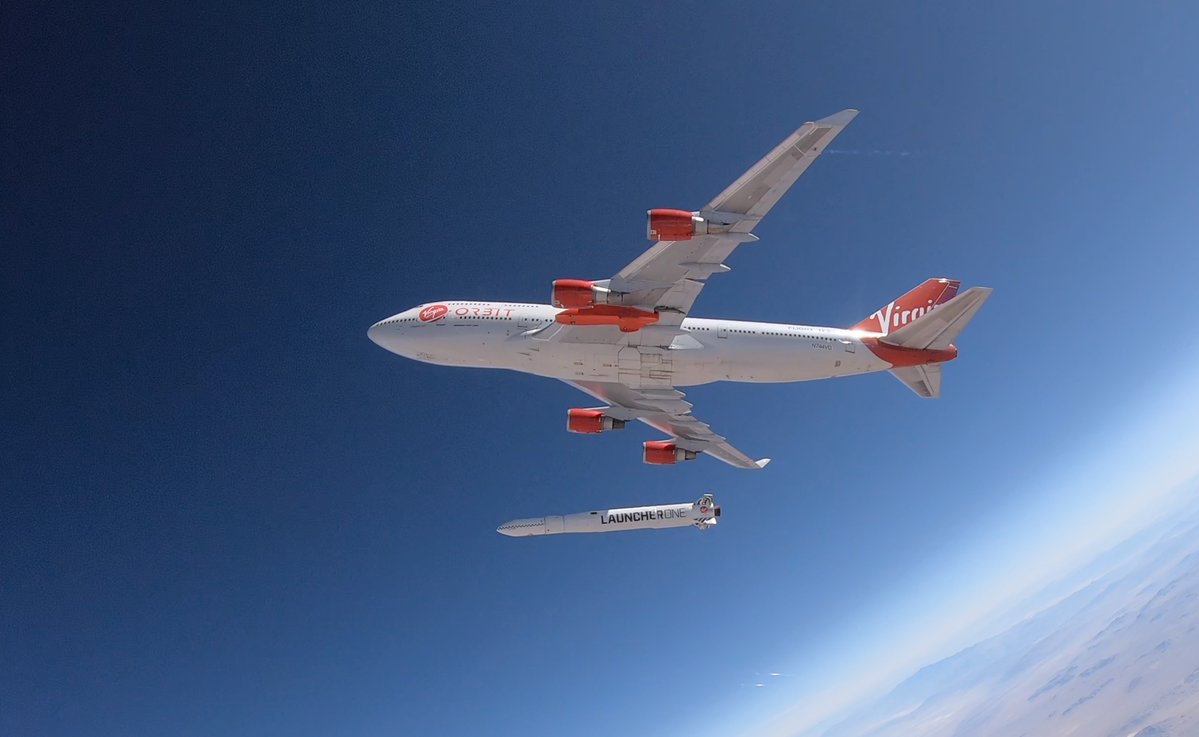
A full-scale model of Virgin Orbit’s air-dropped small satellite launcher, filled with water and antifreeze instead of rocket fuel, fell away from the wing of a modified Boeing 747 carrier jet Wednesday and impacted on a test range at Edwards Air Force Base in California, a key test that paves the way for the company’s first space mission later this year.
Backed by billionaire entrepreneur Richard Branson, Virgin Orbit aims to carve out a slice of the growing small satellite launch market alongside Rocket Lab and other companies.
Wednesday’s drop test was the last major milestone in Virgin Orbit’s test program, signaling the start of a transition from rocket development to launch operations, according to Dan Hart, the company’s CEO.
“We have a very happy team up here in Mojave,” Hart told Spaceflight Now after Wednesday’s test. “The flight crew was just grins when they got off the airplane, and there are a lot of high-fives and hugs going on here.”
Established in 2017 as a spinoff from Virgin Galactic, Branson’s suborbital space tourism company, Virgin Orbit plans to base its early missions from Mojave Air and Space Port in California, then branch out to other airports. Future LauncherOne staging bases could be located at NASA’s Kennedy Space Center in Florida, Cornwall Airport Newquay in southwest England, Taranto-Grottaglie Airport in Italy, a location in Guam, and an airport in Japan.
Virgin Orbit’s Boeing 747 carrier aircraft, named “Cosmic Girl,” took off from Mojave on Wednesday morning and climbed to 35,000 feet (nearly 10,700 meters). Pilots Kelly Latimer and Todd Ericson pointed the jumbo jet upward at an angle of more than 25 degrees, then commanded the release of the LauncherOne vehicle from a pylon under the 747’s left wing around 9:13 a.m. PDT (12:13 p.m. EDT; 1613 GMT), mimicking maneuvers they will execute during a real launch.
Four Virgin Orbit engineers were also aboard the carrier jet Wednesday.
Now THAT’s what I call a drop test! Video from today’s very successful drop test of our #LauncherOne small satellite launch vehicle. More photos and videos coming soon. pic.twitter.com/aOib4HYVPU
— Virgin Orbit (@Virgin_Orbit) July 10, 2019
On an actual mission, the two-stage LauncherOne vehicle will be filled with liquid rocket propellants. For Wednesday’s test, ground crews loaded the tanks with water and antifreeze to simulate the propellant, giving the rocket a weight of about 57,000 pounds (about 26 metric tons).
Engineers planned the drop test to gather data on the aerodynamic loads the carrier aircraft will experience when it sheds the nearly 30-ton rocket. Virgin Orbit also wanted to observe how the instrumented LauncherOne test vehicle performed in the first few seconds after release.
Reports from the 747 flight crew, and a quick-look review of video and telemetry data, suggested everything worked perfectly Wednesday.
The drop test was the culmination of a series of captive carry test flights since November with the inert LauncherOne vehicle under the 747 carrier jet, a former passenger airliner operated by sister company Virgin Atlantic. Ground crews stripped around 30 tons of weight and passenger seats from the airplane to allow it to haul the LauncherOne rocket aloft.
“It’s been a long and hard flight test program, as flight test programs often are, and this is our capstone event, so we’re pretty happy about it,” Hart said. “The system performed really, really well.”
“The whole flight went incredibly well,” said Latimer, Virgin Orbit’s chief test pilot, in a statement. “The release was extremely smooth, and the rocket fell away nicely. There was a small roll with the aircraft, just as we expected. Everything matched what we’d seen in the simulators well — in fact, the release dynamics and the aircraft handling qualities were both better than we expected. This was the best kind of test flight sortie from a test pilot’s perspective — an uneventful one.”
Virgin Orbit intended the drop test as a full-up practice run to gain confidence as engineers head into the company’s first launch campaign.
“Except for the geography — we flew over Edwards — everything else was an exact mission simulation, including having our ground tracking and S-band (telemetry system) going with all the data transmitting,” Hart said. “We had a guidance system operating so we could fully understand how the vehicle was operating on the way down.”
During LauncherOne’s first orbital mission, the carrier aircraft will depart Mojave and head over the Pacific Ocean to release the rocket, which will ignite moments later to climb into space.
The 70-foot-long (21-meter) two-stage LauncherOne vehicle is designed to propel payloads of up to 1,100 pounds (500 kilograms) into a low-altitude equatorial orbit, or up to 661 pounds (300 kilograms) to a 310-mile-high (500-kilometer) sun-synchronous polar orbit.
Virgin Orbit is selling LauncherOne missions for around $12 million, and has already cinched contracts with NASA, the U.S. Air Force, and several commercial customers.
Drop test signals Virgin Orbit’s transition into launch operations
The next time “Cosmic Girl” takes to the skies with a rocket, it will carry aloft a space-worthy version of Virgin Orbit’s LauncherOne, a vehicle now being assembled inside the company’s factory in Long Beach, California.
“This was really the last big non-mission demonstration test, so starting this afternoon, we’re in pre-launch mode,” Hart said Wednesday.
If everything goes according to plan, Hart said LauncherOne could launch into orbit by the end of the summer,
Engineers finished a series of hold-down engine firings in May to qualify the rocket’s propulsion systems for flight.
The NewtonThree engine on the first stage will generate 73,500 pounds of thrust in vacuum, firing for around three minutes on each mission. The second stage’s NewtonFour engine will ramp up to 5,000 pounds of thrust, and can be reignited in space to maneuver into different orbits.
At Virgin Orbit’s Long Beach factory, technicians are finishing assembly of the first LauncherOne vehicle to fire into space. They plan to mate the rocket’s two stages later this month, officials said, then hand over the launcher to Virgin Orbit’s operations team.
The rocket will trucked to Mojave for attachment to the “Cosmic Girl” jumbo jet.
“We have a rocket in the factory,” Hart said. “It’s integrated. It’s been through some of the more complex integrated system checkouts. We’ve still got a little ways to go, but if everything goes well, we’ll have it delivered, and we’ll start doing wet dress rehearsals, and the kinds of things you do before you actually launch a rocket for the first time.”
The wet dress rehearsals will involve filling the rocket with cryogenic fluid for the first time to practice fueling operations.
“Part of our first flight campaign will be to take our flight rocket and do one flight test with cryogenics on-board before launch,” Hart said. “We plan to use liquid nitrogen, so we don’t have our first time with cryogenics with liquid oxygen. That’s the way we kind of ease into that first flight.”
Unlike Northrop Grumman’s air-launched Pegasus rocket, which burns pre-packed solid propellant, the liquid-fueled LauncherOne vehicle will rely on cryogenic liquid oxygen chilled colder than minus 298 degrees Fahrenheit (minus 183 degrees Celsius).
The LauncherOne engines will consume liquid oxygen in a mixture with rocket-grade kerosene.
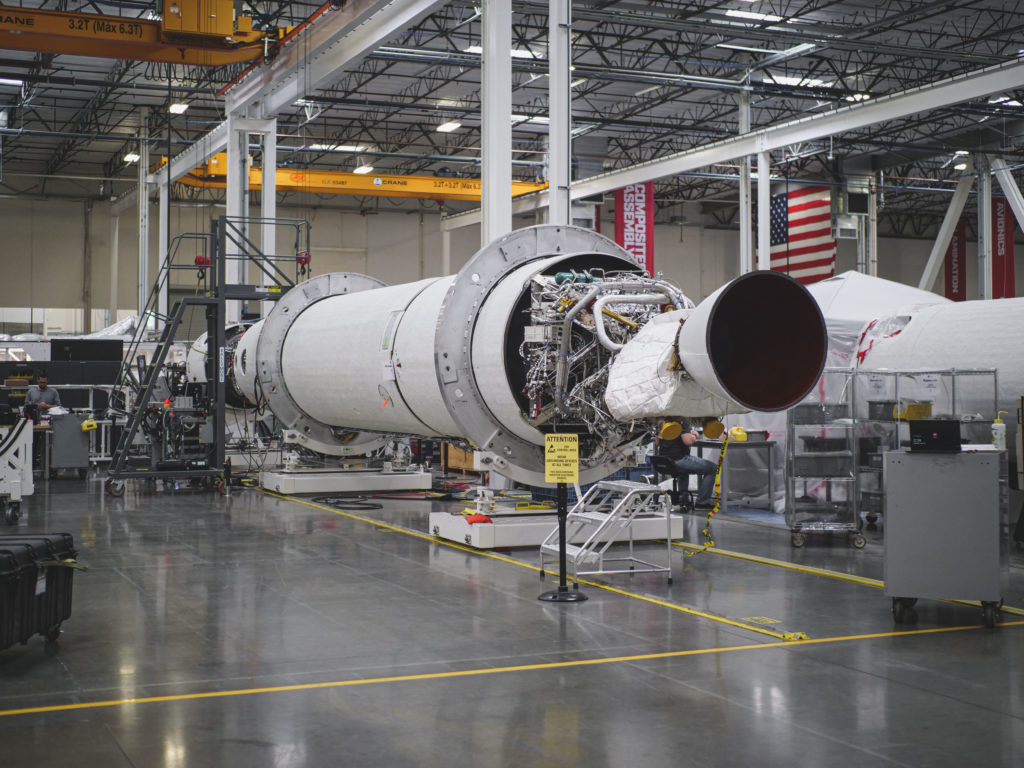
Cryogenic fluids boil off if they get too warm. Rockets launched from the ground typically have their cryogenic propellant supplies continuously replenished until just before liftoff to ensure the tanks are full, but LauncherOne will be disconnected from its propellant supply before takeoff.
LauncherOne’s liquid oxygen tanks are coated with spray-on foam insulation to keep the cryogenic fluid insulated during the climb to the rocket’s release altitude.
“Boil-off has been a focus, but we’ve got the system balanced with the right kind of insulation to where that’s not an issue,” Hart said.
Virgin Orbit’s first test launch could happen in the next two months, Hart told Spaceflight Now on Wednesday.
“If all goes well — and we do have some data to look at and some more testing to do — we’re targeting (a launch) before the end of the summer,” Hart said.
There are no customer satellites on the first LauncherOne mission to orbit.
“It’ll be an engineering test,” Hart said. “We’ll have a payload because we do want to verify payload activities, as well as our payload operations, but it’s an engineering payload, essentially, for the flight test.”
Email the author.
Follow Stephen Clark on Twitter: @StephenClark1.

